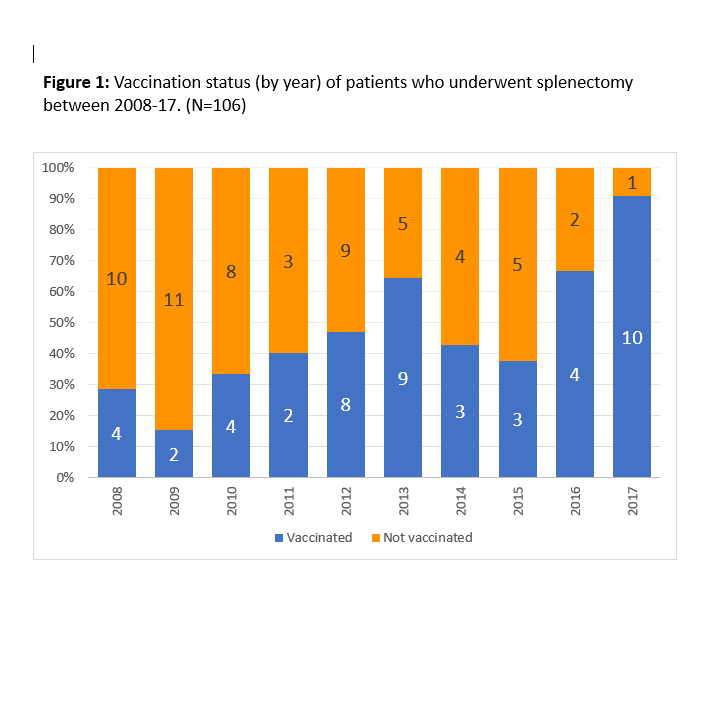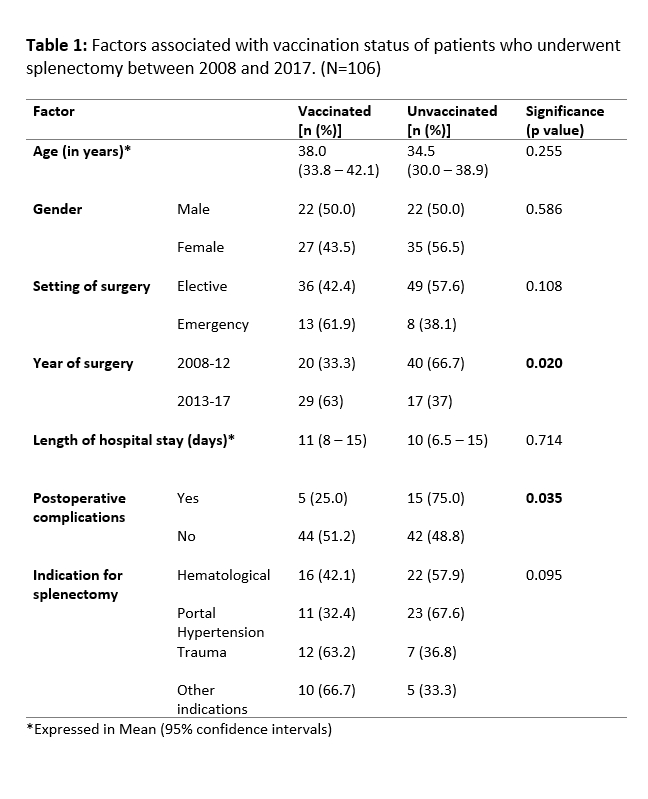POSTSPLENECTOMY PROPHYLAXIS - A TEN-YEAR AUDIT IN A TERTIARY CARE HOSPITAL IN INDIA - A MIXED METHOD STUDY
Vikram Kate*1, Amaranathan Anandhi2, Sathasivam Sureshkumar2, Sathyanarayan Varuna2, Subair Mohsina2, Thulasingam Mahalakshmy3, Nachiappan Deivanai Sundaram2, Ganesh Rajesh Nachiappa4
1Department of General and Gastrointestinal Surgery, Jawaharlal Institute of Postgraduate Medical Education and Research (JIPMER), Pondicherry, India; 2Department of Surgery, Jawaharlal Institute of Postgraduate Medical Education and Research (JIPMER), Pondicherry, India; 3Department of Preventive and Social Medicine, Jawaharlal Institute of Postgraduate Medical Education and Research (JIPMER), Pondicherry, India; 4Department of Pathology, Jawaharlal Institute of Postgraduate Medical Education and Research (JIPMER), Pondicherry, India
Introduction:
Patients undergoing splenectomy are at a higher risk of overwhelming infections by encapsulated organisms and the main prevention strategy is vaccination and antibiotics. However, there is a shortfall in meeting the standards of prophylaxis. Hence, this study was carried out to assess the vaccination coverage over the last ten years and to identify barriers to vaccination and the knowledge, attitude and practices among surgical residents.
Methods:
A retrospective and prospective analysis of post splenectomy vaccination over a period of ten years (2008-2017) was undertaken, from data retrieved from hospital records. The factors affecting the vaccination status were assessed. An assessment of knowledge, attitude and practices among 50 surgical residents was also carried out using a questionnaire. A Key Informant Interview was conducted for 3 senior residents in the Department of Surgery, to assess the perceived barriers hindering vaccination coverage.
Results:
A total of 106 patients were included in the study. Of these, 49/106 (46.2%) had been vaccinated with at least one vaccine. 37/49 had complete vaccination and antibiotic coverage. Vaccination and antibiotic prophylaxis was significantly better in 2017 (91%) than in 2008 (28.6%) [Figure 1]. Also, the development of postoperative complications was noted to affect the vaccination status adversely (25% vs 51%, p=0.035) [Table 1]. 56/106 (52.8%) patients had appropriate documentation in the discharge summary. According to the residents interviewed, logistics, high cost and poor documentation were discerned to be the major hindrances to vaccination coverage. Of 50 surgical residents, 35 (70%) knew what vaccines should be given; Senior and 3rd-year junior residents were more likely to respond correctly than 1st/2nd years (88% vs 52%, p=0.005). Most residents said they have ensured prophylaxis, documentation and counselling of >50% of patients they managed.
Conclusion:
Post splenectomy prophylaxis coverage was poor, but trends show a significant upswing in coverage over the years. High cost, poor availability and scanty documentation were the major impediments to vaccination. Senior surgical residents had better knowledge about the vaccination and antibiotic prophylaxis than their junior colleagues.

Back to 2019 Posters




